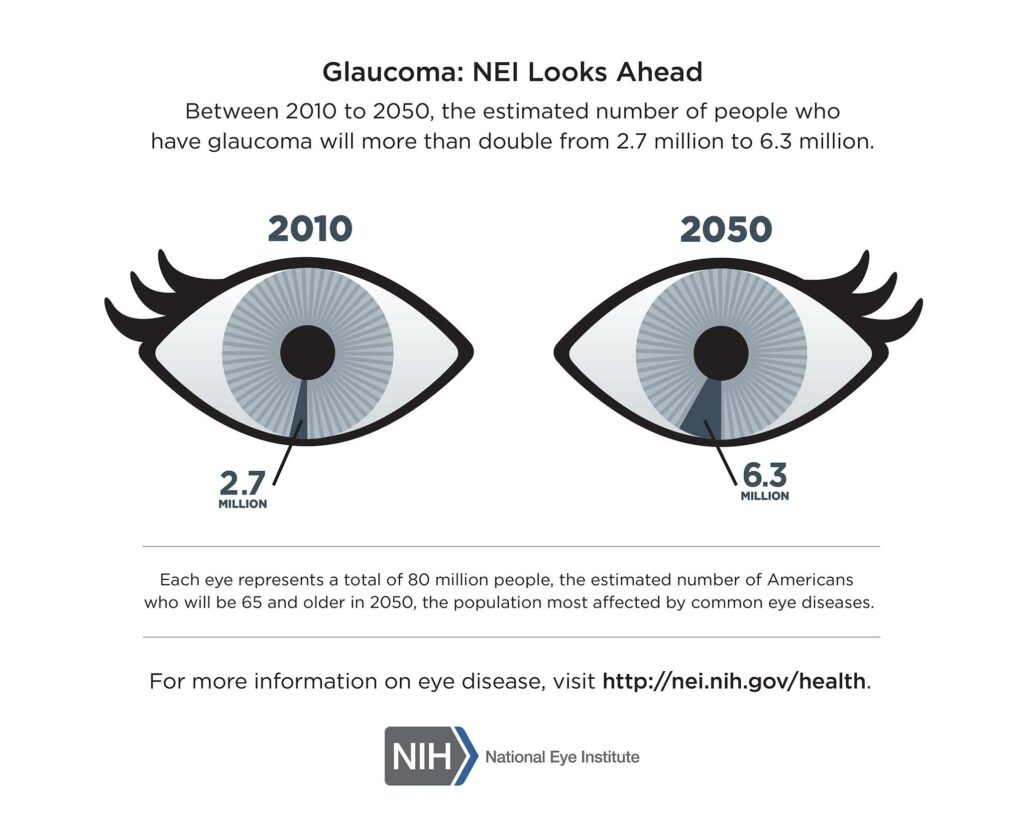This content is also available in:
Español (Spanish)
 Chart Showing Increase in Glaucoma Cases from 2.7 to 6.3 Million from 2010 to 2050
Chart Showing Increase in Glaucoma Cases from 2.7 to 6.3 Million from 2010 to 2050
As we end Glaucoma Awareness Month and begin Low Vision Awareness Month, it is important to be aware of new glaucoma treatments and the implications of glaucoma for visual functioning and daily tasks.
What is Glaucoma?
“Glaucoma is a group of eye diseases that can lead to blindness by damaging the optic nerve. The eye continuously produces an aqueous fluid that must drain from the eye to maintain healthy eye pressure.” (Glaucoma – VisionAware). Further, “Glaucoma can be treated, but it is not curable. The damage that has happened to the optic nerve from glaucoma is irreversible. However, lowering the pressure in the eye can help prevent further damage to the optic nerve and further peripheral vision loss.”. A comprehensive eye exam is the only way to detect glaucoma.
What is Low Vision?
Low vision means that even with regular eyeglasses, contact lenses, medication, or surgery, it may be hard to carry out daily tasks such as reading mail, shopping, preparing meals, and signing your name.
What Do You Need to Know about Low Vision and Glaucoma?
A recent article in the American Academy of Ophthalmology (AAO) cited the Collaborative Initial Glaucoma Treatment Study (CIGTS), which concluded that more than 25% of newly diagnosed glaucoma patients report problems with seeing, including blurred vision, adaption to light and dark as well as seeing at night, and issues with bright lights.
Why is this Finding Important?
A traditional way of thinking about the loss of vision with glaucoma is that it gradually affects peripheral vision. However, as noted in the AAO article, it is important that doctors and patients both understand the additional issues that glaucoma patients may have in mobility, reading, and driving, although they are not legally blind. These losses are all associated with higher rates of depression and anxiety.
 Image Depicts Glaucoma Tunnel Vision
Image Depicts Glaucoma Tunnel Vision
Components of a Low Vision Exam and Services Recommended for a Glaucoma Patient
Getting a low vision exam and finding out about devices and low vision rehabilitation are critical to the quality of life of a person with glaucoma. The AAO article details what a low vision exam of a glaucoma patient should cover—including screening functional abilities; testing visual acuity, contrast sensitivity, and need for lighting; checking visual fields; observing the patient carrying out activities; testing for magnification, field enhancement, and glare control; referral for training in activities of daily living and orientation and mobility; discussing mental health options including support groups.
What Do Glaucoma Patients Say?
“The loss of vision in my left eye was a game changer. It seemed like I had no depth perception. I immediately started using a white cane for mobility, which was a tremendous help.” Joe Lovett, Glaucoma Patient.
“There are too many people with vision loss who could benefit from much earlier diagnosis and intervention and dramatically increased awareness of what’s possible in vision rehabilitation. I would ask that physicians don’t wait until we’ve lost much of our vision before they talk to us about vision rehabilitation, including the services and resources that can help us live most effectively and plan positively for the future.” Joe Lovett: Activist and Documentary Filmmaker – VisionAware
“I avoid driving now, and my balance and depth perception are off. Despite these challenges, I’m still active outdoors with hiking, biking and kayaking; but I always go with a friend now. I use a walking stick to help with balance, and the places I go are not quite so adventurous – I stick to flat trails and calm water.” Phil Shanholtzer in Glaucoma: An Eye Condition with Worldwide Impact.
New Treatment Options for Glaucoma
According to the Glaucoma Research Foundation, some new medications and other types of treatment are now available for managing glaucoma. These include using laser trabeculoplasty (SLT) as the initial treatment as well as “micro-invasive glaucoma surgery” (MIGS), which are new, safer surgery options.
The two new categories of glaucoma medications are nitric oxide-donating prostaglandins and Rho kinase inhibitors. Both lower interocular pressure (IOP) by using only them once a day. The further good news about these medications is that they lower IOP greatly, are comparable to other glaucoma medications, have few side effects, and offer an innovative way to improve the drainage of fluid from the eye.
For patients who have had to take multiple doses, these new medications can help simplify their medication schedule. They will also help individuals with cardiovascular disease who cannot take the side effects of other types of glaucoma medications like beta blockers or alpha agonists.
References
Aref, A. A., & Kaleem, M. (2022, December 24). Low vision and vision rehabilitation in glaucoma. EyeWiki. Retrieved January 24, 2023, from https://eyewiki.aao.org/Low_Vision_and_Vision_Rehabilitation_in_Glaucoma
Mills, R., et al. (2001, October 3). Correlation of visual field with quality-of-life measures at diagnosis in the collaborative initial glaucoma treatment study (CIGTS). Journal of Glaucoma. 192-198.
Okeke, C. (2020, February 14). New treatment options for managing glaucoma. glaucoma.org. Retrieved January 24, 2023, from https://glaucoma.org/new-treatment-options-for-managing-glaucoma/?msclkid=8854bc7dc20214f025dcdfb0e32d6efc&utm_source=bing&utm_medium=cpc&utm_campaign=Glaucoma-+Blog&utm_term=treatment+options+for+glaucoma&utm_content=New+Glaucoma+Treatment+Options
Learn More
The link between Glaucoma and Mobility (pacificmobility.com)
Patient’s Guide to Living with Glaucoma – VisionAware